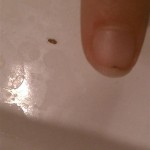How to Caulk Under Bathroom Sink
A properly caulked seam between the bathroom sink and the countertop provides a crucial barrier against water damage. Caulk prevents water from seeping into the cabinet below, where it can cause mold, mildew, and deterioration of the cabinet materials. This guide outlines the necessary steps to achieve a professional-looking and effective caulk seal.
Gathering the Necessary Tools and Materials:
Successful caulking requires specific tools and materials. These include:
-Caulk: Choose a high-quality, 100% silicone caulk specifically designed for bathrooms. Silicone caulk is flexible, waterproof, and resistant to mold and mildew growth. Look for options labeled "kitchen and bath" or "sanitary." Avoid using acrylic latex caulk, as it is not as durable or water-resistant.
-Caulk Gun: A standard caulking gun will provide the necessary control and pressure for application.
-Utility Knife or Razor Blade: This is essential for removing existing caulk.
-Putty Knife: Useful for removing stubborn old caulk and smoothing the new bead.
-Painter's Tape: Applying painter's tape on either side of the gap creates clean, straight lines and prevents caulk from getting on the countertop and sink.
-Rubbing Alcohol or Mineral Spirits: Used to clean the surfaces before caulking.
-Clean Rags or Paper Towels: Essential for cleanup.
Preparing the Surface:
Proper surface preparation is critical for achieving a long-lasting caulk seal. The surface must be clean, dry, and free of any debris. Begin by removing the old caulk. Using the utility knife or razor blade, carefully score along the edge of the existing caulk bead. Then, use the putty knife to pry the old caulk away from the surface. Be careful not to scratch the sink or countertop.
Once the old caulk is removed, thoroughly clean the area with rubbing alcohol or mineral spirits. This removes any residual soap scum, mildew, or other contaminants that could interfere with the adhesion of the new caulk. Ensure the surface is completely dry before proceeding.
Applying Painter's Tape (Optional but Recommended):
While optional, using painter's tape is highly recommended, especially for those less experienced with caulking. Apply the tape along the edge of both the sink and the countertop, leaving a small gap where the caulk will be applied. This gap should be slightly wider than the anticipated caulk bead. The tape acts as a guide and prevents the caulk from spreading onto unwanted areas, resulting in a neat and professional finish.
Applying the Caulk:
Cut the tip of the caulk tube at a 45-degree angle, using a utility knife. The size of the hole will determine the thickness of the caulk bead. Start with a small opening and enlarge it if necessary. Load the caulk tube into the caulking gun.
Holding the caulking gun at a 45-degree angle, apply a continuous bead of caulk along the gap between the sink and the countertop. Maintain consistent pressure on the trigger to ensure an even flow of caulk. Avoid stopping and starting in the middle of a run, as this can create gaps or inconsistencies in the bead.
Smoothing the Caulk Bead:
Immediately after applying the caulk, use a wet finger or a caulk smoothing tool to smooth the bead and ensure good contact with both surfaces. This also helps to force the caulk into the gap, creating a stronger seal. If using your finger, dampen it with water or rubbing alcohol to prevent the caulk from sticking. Remove any excess caulk with a damp rag or paper towel.
Removing the Painter's Tape:
If you used painter's tape, carefully remove it while the caulk is still wet. Pull the tape away at a 45-degree angle to avoid disturbing the caulk bead. This will leave a clean, straight line.
Allowing the Caulk to Dry:
Allow the caulk to dry completely according to the manufacturer's instructions. This typically takes between 24 and 48 hours. Avoid using the sink during this time to prevent disturbing the caulk and compromising the seal. Once the caulk is fully cured, it will be waterproof and provide a durable barrier against water damage.
Maintaining the Caulk Seal:
Regular cleaning and inspection of the caulk seal are important for prolonging its life. Clean the caulk regularly with a mild soap and water solution. Inspect the caulk periodically for any signs of cracking, peeling, or mildew. If any damage is observed, remove the old caulk and reapply a new bead following the steps outlined above.
How To Re Caulk A Bathroom Sink Ifixit Repair Guide

How To Caulk A Bathroom Sink 12 Steps With Pictures Wikihow
How To Re Caulk A Bathroom Sink Ifixit Repair Guide

How To Caulk A Bathroom Sink 12 Steps With Pictures Wikihow

How To Re Caulk A Sink

How To Caulk A Bathroom Sink 12 Steps With Pictures Wikihow

How To Caulk A Bathroom Sink

Here S How To Caulk Around Bathroom And Kitchen Fixtures
How To Re Caulk A Bathroom Sink Ifixit Repair Guide

How To Caulk A Bathroom Sink 12 Steps With Pictures Wikihow
Related Posts







